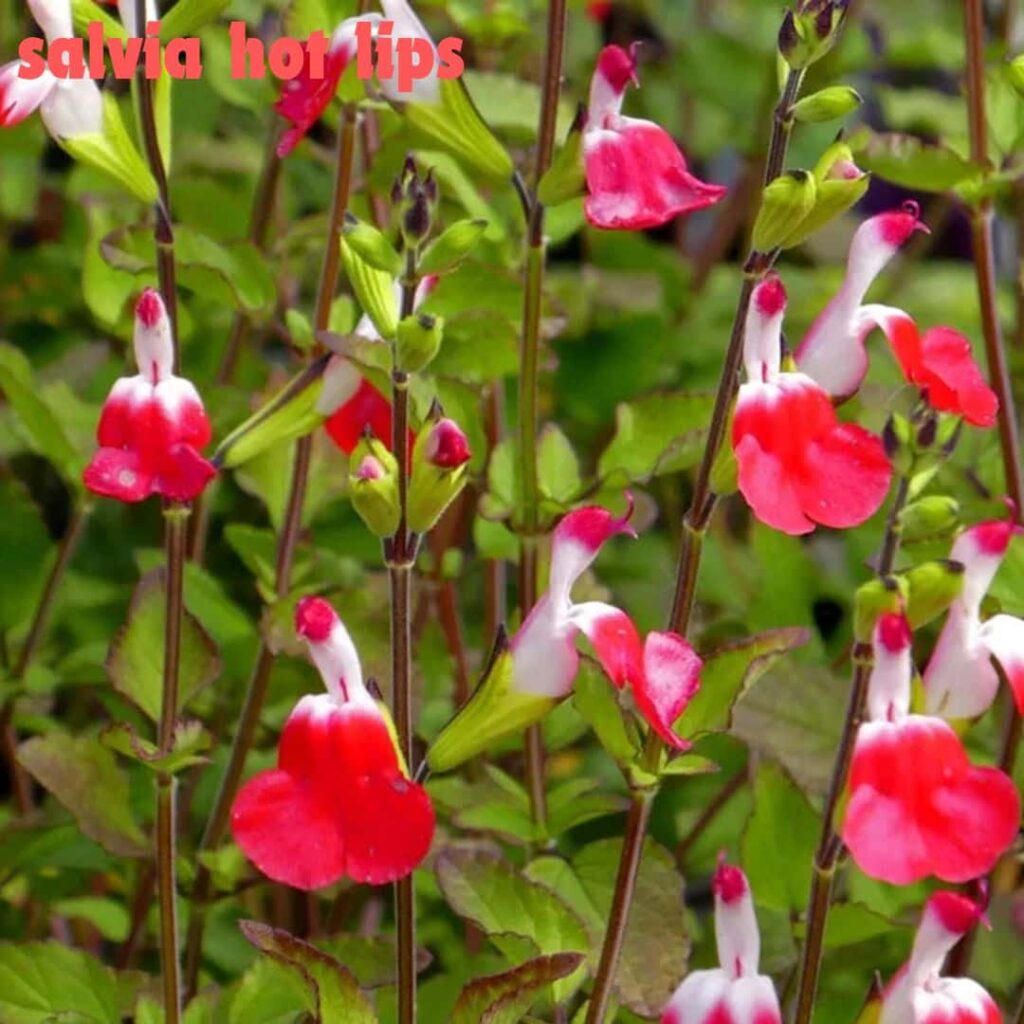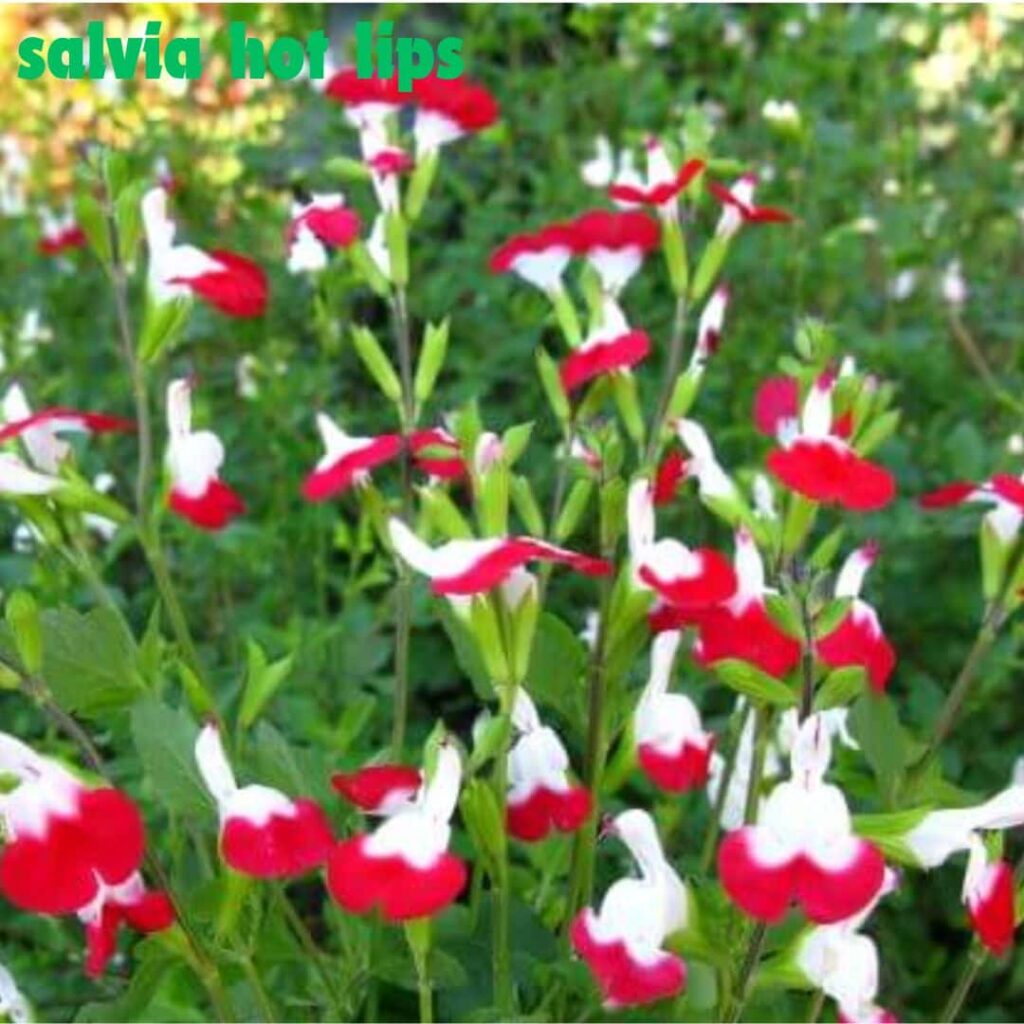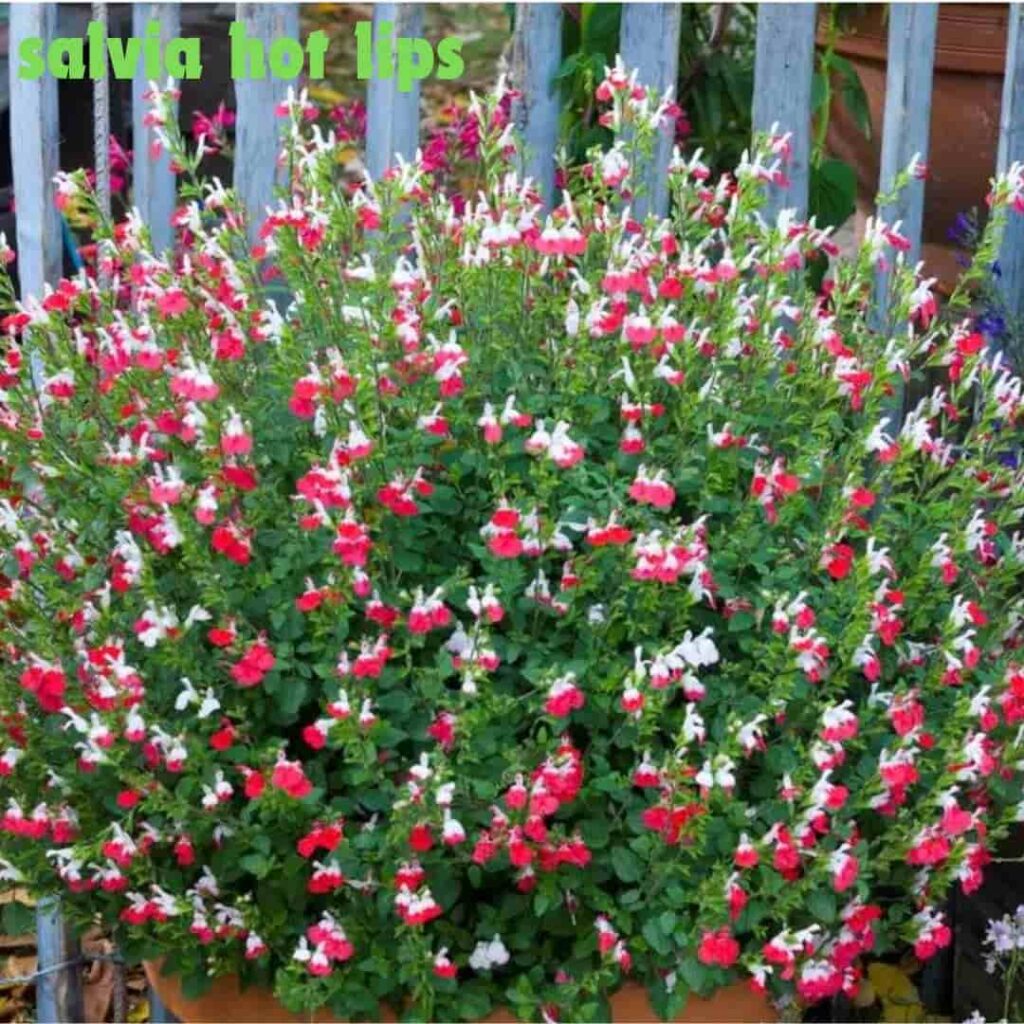Guide to Grow Best Salvia Hot Lips Origin & Diseases
Salvia Hot Lips is an exotic long-lived plant that has a distinct two-styled inflorescence. This one from the smart family is as appropriately named Salvia microphylla, has a spectacular display of red and white flowers and hammers home a familiar dictum among horticulture workers and outer decorators.
These beautiful flowers are lovely and practical, pulling in different pollinators like honey bees, butterflies, and hummingbirds. The actual plant is underrated, commonly between 1 to 3 feet level. Its vegetation is perfumed and adds an extra real component to gardens.
Origin and History
Deriving from Mexico, Salvia Hot Lips has gained worldwide esteem and become a symbol of versatility and decorative allure. First introduced to broader green circles in the late twentieth century, it has since become a garden staple, adorning landscapes across the globe.

Its unique hue, a serendipitous discovery in a cluster of seedlings, has sparked a global trend among plant enthusiasts and gardeners, inspiring them to add a splash of this vibrant variety to their gardens.
Characteristics of Salvia Hot Lips
Select Parts: What separates them is their unique bicolor flowers. The petals are prevalently white with unique red tips, which look like the state of lips and are called “Hot Lips.”
This striking contrast makes an unusual showcase mainly attractive in garden settings. Another eminent component is its sweet-smelling foliage, which delivers a lovely perfume when brushed or squashed, adding a layer of real attraction to the plant.
Product Disposition: Salvia Hot Lips is a minimal, hairy plant that normally arrives at levels of 1 to 3 feet. It has a thick growth bent with various branches, making it an unusual decision for edges and fences.
The plant’s leaves are little, oval-formed, and have a somewhat fluffy surface. Its lively nature allows it to flourish in various nursery settings, giving a lavish set to its active blooms.
Blossoming Season: One of the promoter elements of Salvia Hot Lips is its drawn-out flowering season. The plant starts to succeed pre-summer and gives blossoms into the fall.
This long, blossoming period guarantees that greenhouses stay brilliant and active for most of the year. The continued sprouting makes it an important plant for drawing in pollinators throughout the newborn season.
Advantages of Growing
Pulling in Pollinators: This amazing flower is a magnet for pollinators like bumble bees, butterflies, and hummingbirds. The lovely red and white blooms are lovely to these animals, giving a solid mine of nectar throughout the creating season.
By laying out Salvia Hot Lips, greenhouse laborers can help support nearby pollinator peoples, which are bad for the strength of different organic frameworks.
Intense Care: One of the most important gifts is its low-upkeep nature. This solid plant is dry spell open-minded once settled, needing little watering compared with other greenhouse plants.
It is likewise impossible to multiply typical slime and illnesses, making it an ideal conclusion for landscapers who need an amusing, object-free plant.
Ideal Growing Conditions
Soil Conditions: It advances in well-depleting soil. While it is universal to different soil types, it prefers sandy or soil-like soils that take care of significant waste. To upgrade soil quality, blend in a natural matter like fertilizer or bad compost before planting.
Please avoid weighty earth soils as they hold an extra dampness, which can produce root pollution.
Light Tilts: This plant values the sun and performs best when selected in full daylight. Preferably, Salvia Hot Lips should get 6 to 8 hours of direct sunlight daily.
While it can endure in complete shade, extreme shade can diminish flowering and lead to leggy growth. Ensure that it is established where it can absorb a lot of beams to deliver its best flowers.
Watering Needs: Salvia Hot Lips is generally dry season forgiving once paid. During the underlying selecting stage, keep the dirt reliably damp but not waterlogged. After the plant is laid out, mainly after the direct-developing season, it requires less continuous watering.
Water profoundly yet rarely, allowing the ground to dry out between watering meetings. Overwatering can be negative, starting root pollution and different problems.
How to Plant
Selecting the Right Area: Select an area that offers a full day and has well-depleting soil. The region is a secure area of strength, as the plant can be powerless to harm. A location close to a patio or course is perfect, as it lets you partake in the sweet-smelling foliage and active flowers very close.

Selecting Actions Set up the Dirt: Alter the soil with waste or natural to make a difference in further designing waste and complement range.
Dig an Opening: Search for an opening that is two times as broad and as deep as the plant’s root ball.
Position the Plant: Dot the plant in the opening, ensuring that the highest point of the root ball is level with the ground surface. Inlay and Water: Fill the opening with soil, pushing down delicately to wipe out airbags. Water assists the plant with relaxing.
Managing Salvia
Watering Program: Once paid, Salvia Hot Lips needs a little watering. During droughts, water the plant profoundly about one time per week.
The land is secured to dry out between watering and forestall soul decay. In hot environments, you power have to water all the more regularly; regardless, always, look at the dirt water first.
Medicine Information: It doesn’t need weighty care. A light utilization of modified, slow-discharge waste in late winter can uphold sound products and plentiful blooming.
Abstain from over-treating, as this can prompt excessive foliage development to the penalty of flowers. Natural alternatives like fertilizer or fish emulsion can likewise be helpful.
Pruning Techniques: Regular pruning keeps up with the plant’s shape and energizes more nodes. Cut back any dead or damaged stems in late winter to advance new products.
All through the budding season, deadhead spent flowers to support tenacious sprouting. In pre-winter, you can order the plant back by around 33% to clean it up for winter.
Common Pests and Diseases
Determinating Angers: Salvia Hot Lips is mostly waterproof to multiple offenses, yet it can occasionally draw in aphids, bug parasites, and whiteflies. Aphids are little green or dark bugs that bunch on new products, and smelly fluid, and weaken the plant.
Bug parasites make fine networks on the bottom of leaves, while whiteflies are little, white bugs that fly out when the plant is bitter.
Illness Counteraction: It is relatively illness-free, yet a fair review can forestall likely issues. Ensure great air around the plant to forestall infectious illnesses like light decay. Avoid above water to keep the foliage dry and kill any decreased leaves or waste that can hold onto microorganisms.
Medicine Options: A solid shower of water can remove aphids and whiteflies from the plant. In more severe cases, insecticidal cleaner or neem oil can be employed.
Bug parasites can be made do with normal clouding of the plant, as they succeed in dry cases. If infectious illnesses appear, destroy affected vegetation and apply a fungicide if necessary.
Propagating
Seed Spread: Engendering Salvia Hot Lips from seeds is a direct cycle. Collect seeds from adult plants after the flowers have confused and the seed units have dried. Plant the seeds in a well-depleting seed-beginning mixture and keep them damp.
Germination generally occurs within half a month. When the seedlings are sufficiently large, relocate them into separate pots or straightforwardly into the greenhouse.
Cutting Engendering: Cutting engendering is another booming system. Take 4-6 inch cuttings from sound, non-blossoming stems in pre-summer or late spring. Destroy the lower leaves and dip the cut end to show the chemical.
Plant the cuttings in a pot loaded with a well-depleting training blend, and keep the dirt damp. Place the pot in a warm, glorious area out of direct daylight. The cuttings ought to be inducted in half a month.
Companion Planting
Best Friend Plants: Salvia Hot Lips conforms well with various plants. Consider setting it close by lavender, rosemary, or other Mediterranean spices that enjoy close developing events.
Its active flowers balance delightfully with plants like Russian sage, coneflowers, and yarrow. These blends can make an outwardly amusing and pollinator-accommodating nursery.

Plants to Keep away from: Avoid showing Salvia Hot Lips close to water-cherishing plants, as their irregular water needs can cause support problems. Plants like hostas or greeneries, which incline toward reliably damp soil, are not ideal partners.
Also, try not to put it close to overly forceful or bulging plants that could go after support and space.
Landscaping
Plan Thoughts: Salvia Hot Lips can be used in different scene plans. Its underrated size and glorious flowers make it an amazing conclusion for lines, edging, and rock gardens.
It also functions admirably in holders, where its lively flowers can be displayed on decks or passages. Combine it with wildflower greenhouses or glade-style plantings for a more regular look.
Occasional Interest: This plant gives stable variety from pre-summer to fall. Its constant blossoming and attractive foliage promises that your greenhouse stays rich and graphic for most of the year. The vegetation takes on a special tone in the fall, adding one more layer of periodic welfare.
Harvesting and Usage
Collecting Blossoms: The flowers of Salvia Hot Lips can be organized for different goals. To collect, just cut the stems with flowers in the first part of the day after the dew has parched. Place the sliced stems in water fast to keep them new. Ordering consistently can also urge the plant to produce more flowers.
Culinary Purposes: While not so generally used as different spices, the leaves can be employed in cooking. They have a peaceful, marginally minty taste that can be used in plates of mixed greens, teas, or as a flourish. The blooms are likewise consumable and can add an enhancing contact to words.
Therapeutic Purposes: Salvia has a long history of intent in traditional medicine. While Salvia Hot Lips is primarily created for involved objects, its leaves can be operated in much the same way as other sage mixtures.
They are known for their disinfectant effects and can be used in custom-made solutions for sore throats, stomach-related issues, and skin disorders.
Winter Care
Planning for Winter: In colder conditions, Salvia Hot Lips need security to take the colder time of year. Before the central ice, mulch greatly around the floor of the plant to protect the roots. In particularly difficult conditions, consider wrapping the plant with an ice material or moving holder-developed plants inside.
Overwintering Methodologies: For pruned plants, bring them inside before the main ice. Place them in a cool, magnificent area and reduce watering to mimic winter blahs. For garden plants, rising back the stems after the main ice can assist with forestalling harm.
Assure that the remaining ground parts are very much drained throughout the colder time of year to keep away from root pollution.
Troubleshooting Typical Situations
Yellowing Leaves: Yellowing leaves can be an expression of overwatering or painful seepage. Ensure the dirt is well-depleting and decrease watering reproduction. If the plant is in a pool, make sure that the seepage spaces are not restricted.
Shrinking Issues: Shrinking can happen due to underwatering or excessive intensity. Secure the plant so it gets sufficient water, especially during hot, dry periods. Mulching can assist with soil moisture and keep the roots cool.
Depressing Blossoming: If they aren’t flowering great, it could be because of lacking daylight or supplements. Ensure the plant is in a bright area, and believe in applying proper compost in late winter. Deadheading spent flowers can likewise offer serious blooming.
Conclusion
Salvia Hot Lips is a relaxed and low-support plant that adds active type and demand to any garden. Its attractive bicolor flowers expanded growing season, and ability to draw in pollinators make it an excellent decision for both fledgling and professional landscapers.
With the right respect and design, this strong plant can grow and give delight to your greenhouse for a long time.
FAQS
What is hot lips salvia used for?
The flowers and leaves can also be invested and used to decrease rages and feast coughs. It is grown in Mexico and used to make this healing tea. This plant draws bees, butterflies, and hummingbirds, especially due to its scent of blackcurrant.
Can I eat salvia Hot Lips?
These cosmetic flowers add a delicious hint of blackcurrant flavor to many culinary practices and drinks. Use the petals in oils, vinegar, and butter to make a vibrant complement to salads and pâtés.
Does Salvia Flowers come back every year?
Endures unprotected in a moderate winter. They may need defense in overly long frosts. This plant is constant and does not die off after flowering. It will be produced each season indefinitely if supplied with proper growing necessities.
Does salvia like full sun?
The flowers are especially lovely for bees and other pollinators. For best results, grow Salvia x jamensis ‘Hot Lips’ in well-drained soil in full sun.
Is Salvia good for your hair?
Salvia plebeia extract promotes hair growth and hair strand construction in C57BL/6 mice. SP section was topically applied daily on the shaved dorsal skin of mice for 21 days and hair renewal was marked.
Also Read

For anyone who hopes to find valuable information on that topic, right here is the perfect blog I would highly recommend. Feel free to visit my site Webemail24 for additional resources about Bitcoin.